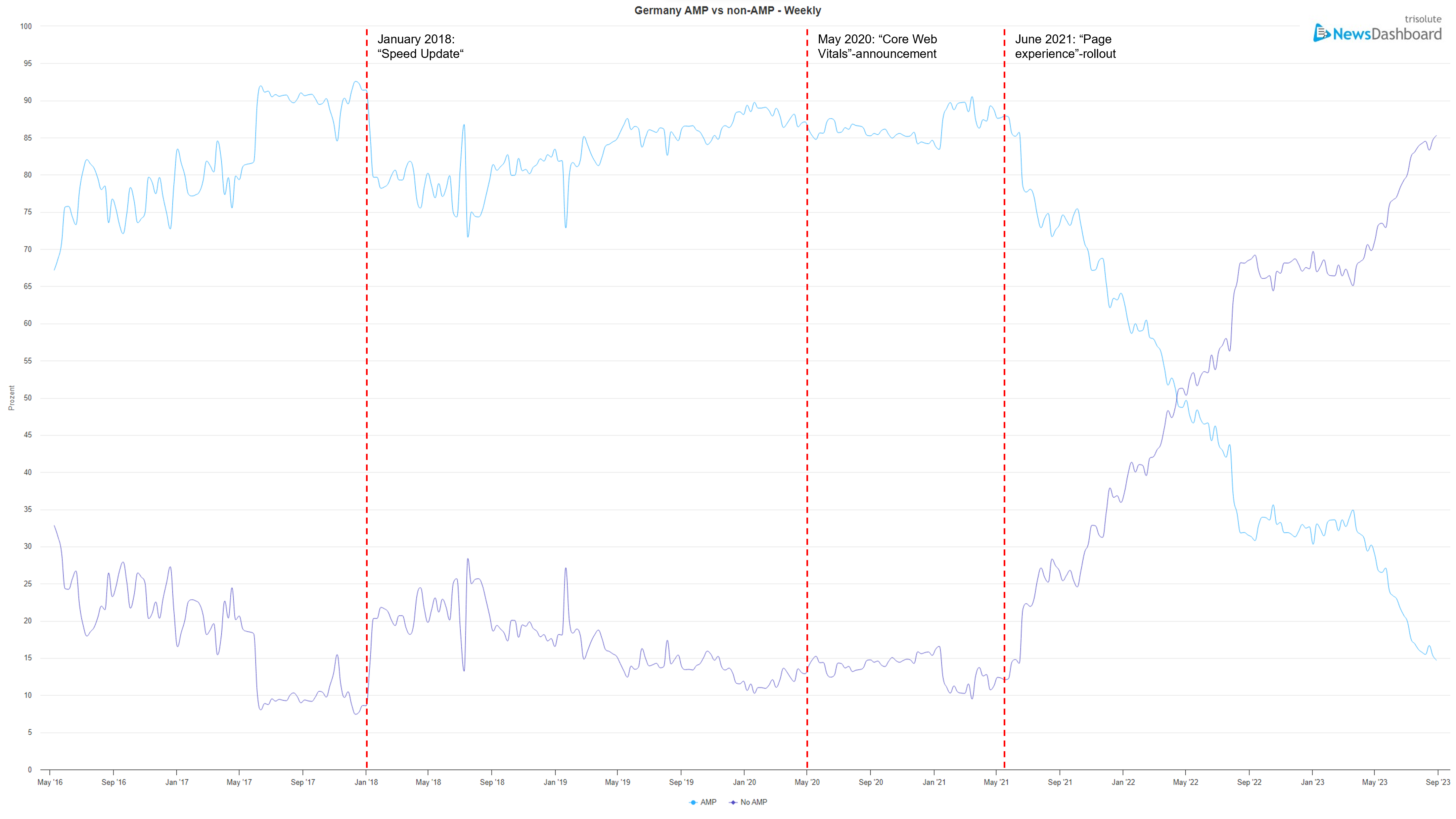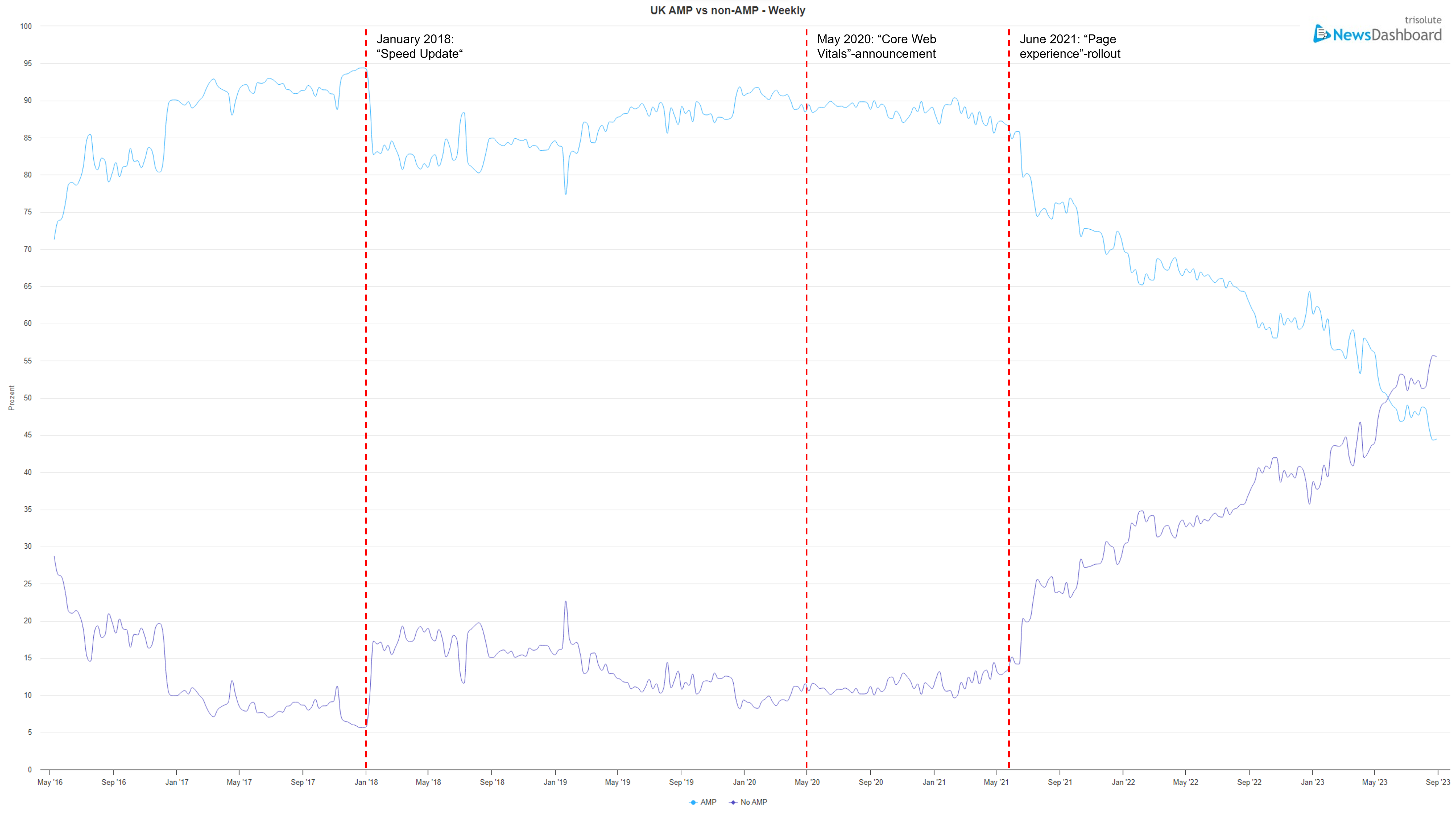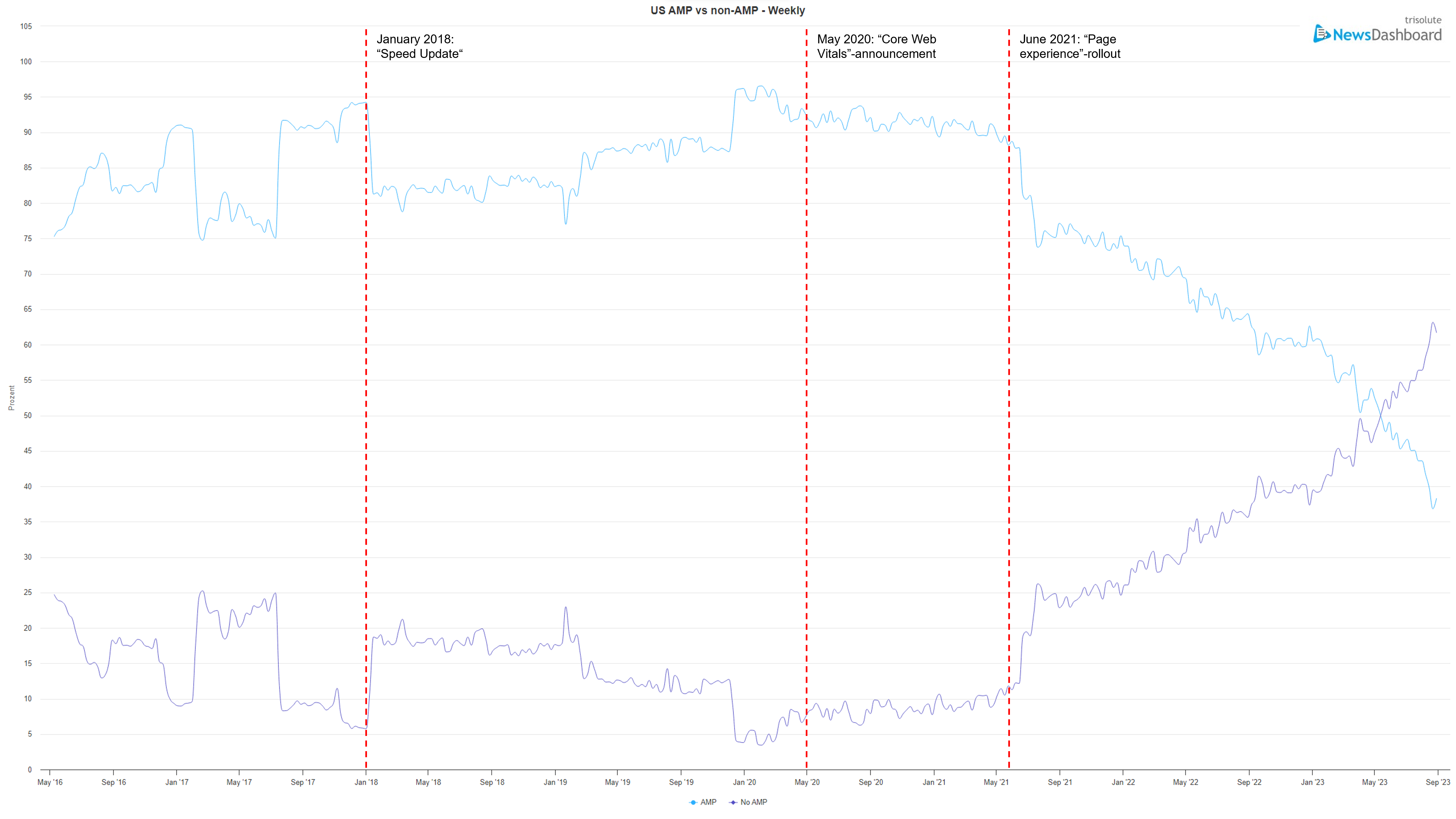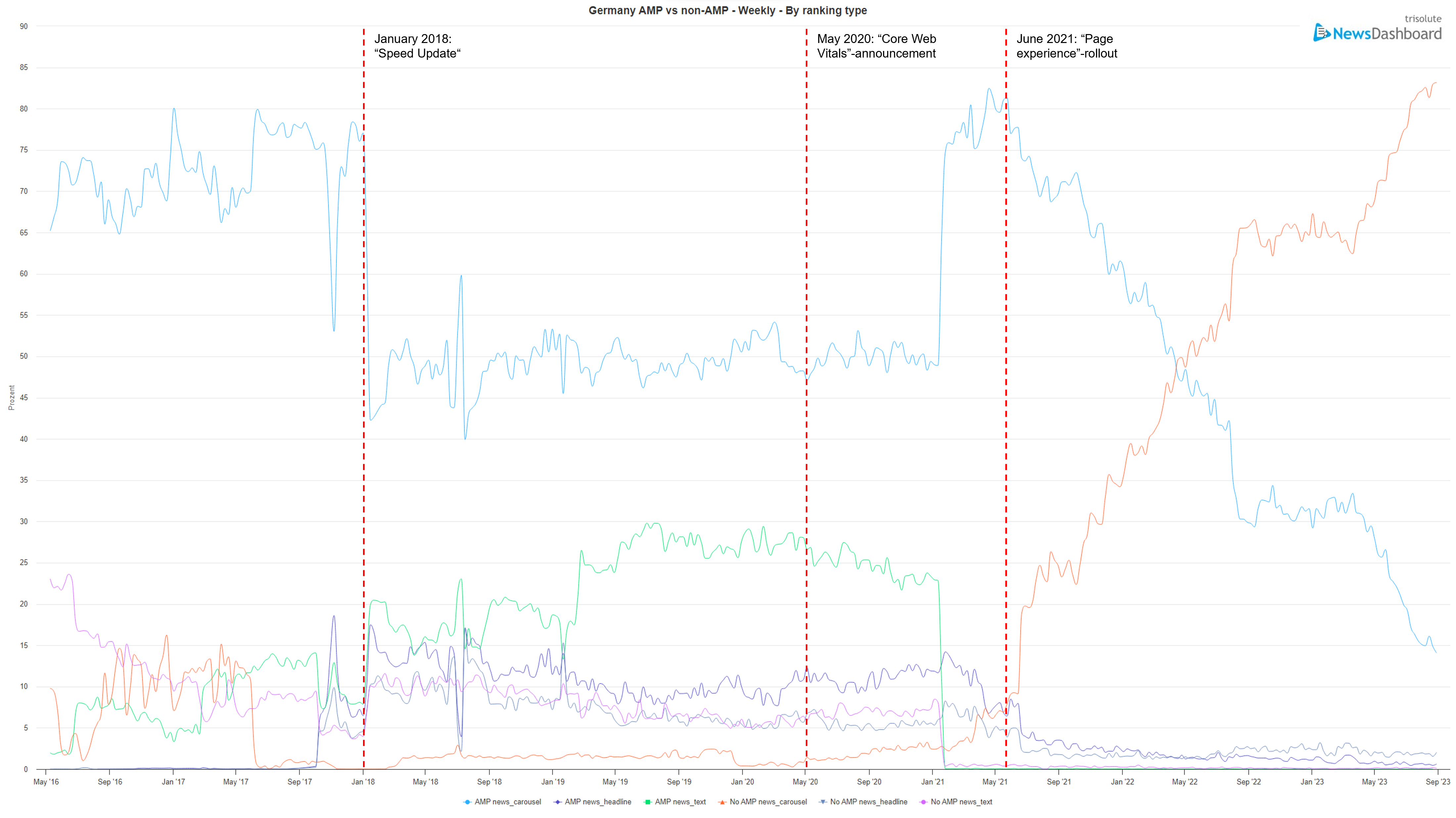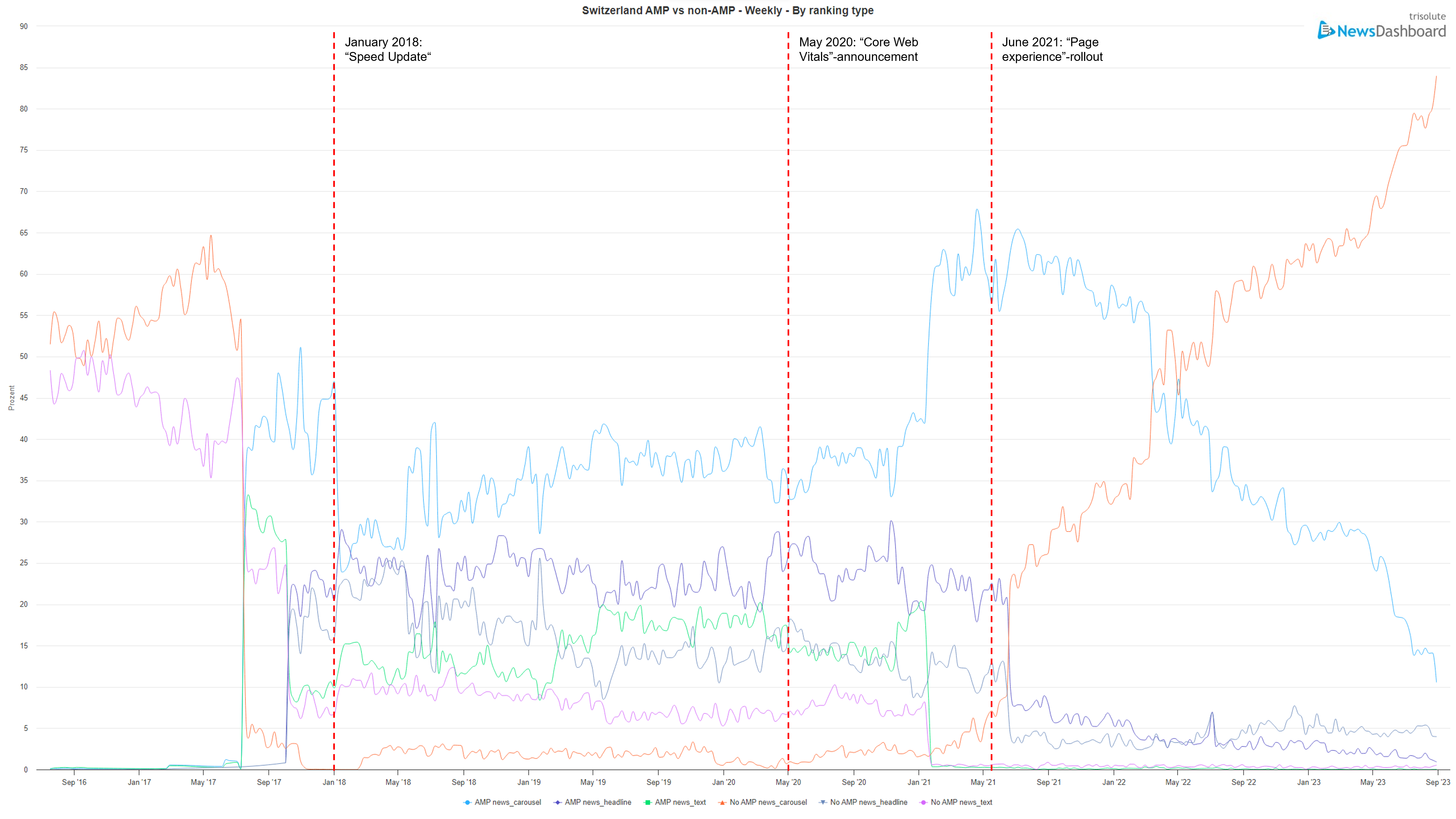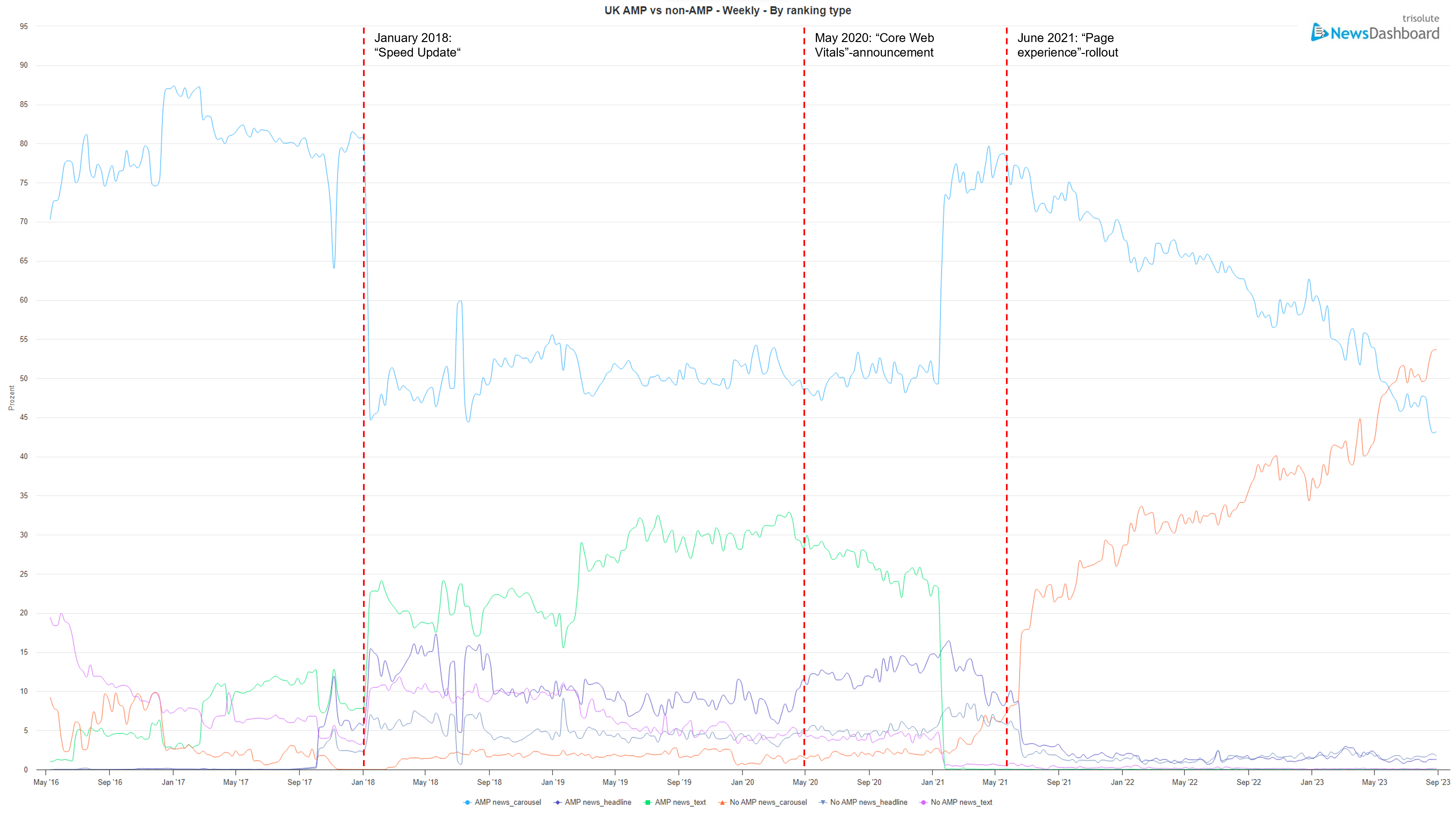Does Google AMP Still Matter for Publishers in 2023?
10. October 2023In the ever-evolving realm of online content, especially on Google, adaptability is the name of the game. As a publisher who strives to optimize their digital offerings, one is inevitably confronted with the question:
Does Google AMP still matter?
To answer this question, in this article we will turn to a thorough analysis of AMP (Accelerated Mobile Pages) usage, drawing insights from exclusive News Dashboard data from four countries: Germany, Switzerland, the United Kingdom, and the United States. This long-term examination spans over an impressive 88 months (more than 7 years!) – from May 2016 to September 2023, providing a great dataset to explore the enduring relevance of AMP.
Our exploration begins with a broad comparison of AMP vs non-AMP usage trends, showing the shifts and dynamics that have transpired over this vast timeframe. Beyond this general overview, we will then dive a little deeper into specific ranking types which can be found on search engine ranking pages (SERPs) – namely, News Carousels, News Headlines, and News Text. How did the AMP-usage within those distinct categories shift during the last 7 years?
Side note: What is AMP exactly?
AMP (Accelerated Mobile Pages) is an open-source web technology, which was introduced by Google in 2016 to enhance mobile web browsing. It provides mobile-optimized web pages that load faster, catering to users who increasingly rely on mobile devices for news and content consumption. What made it especially interesting for some publishers was its improvement of page speed and loading times without making extensive site modifications, relying instead on Google’s AMP platform for user-friendly mobile experiences.
In one simple sentence, Google describes AMP as “[…] a web component framework to easily create user-first experiences for the web“.
As we dive deep into lots and lots of interesting data, we will try to unravel the complex journey AMP has taken over the years, to ultimately discern whether it still remains a crucial tool for news publishers today. For this we want to look into three key industry events that happened throughout those 7 years in detail: the “Speed Update”, the “Core Web Vitals”-announcement, and the “Page experience”-rollout. Let’s have a quick rundown of what happened:
Key events
- “Speed Update” (January 17, 2018):
In January 2018, Google introduced its “Speed Update”. This algorithm change prioritized fast mobile page loading speed as a ranking factor, aligning with Google’s mobile-first indexing shift. It impacted slower-loading mobile pages in search rankings but didn’t specify a fixed speed threshold. The update emphasized user experience and the continuous improvement of page speed, making it particularly relevant for publishers using technologies like AMP. - “Core Web Vitals“-announcement (May 5, 2020):
In May 2020, Google introduced “Core Web Vitals”, a set of user-focused metrics measuring web page performance. These metrics became crucial for assessing page quality and user experience, and while not exclusive to AMP, they underlined the importance of fast and well-structured web pages, aligning with the principles of technologies like AMP. - “Page experience“-rollout (June 15, 2021):
In June 2021, Google rolled out the “Page experience” update, prioritizing user-centric factors in ranking web-pages. This update included “Core Web Vitals”, mobile-friendliness, safe browsing, HTTPS security, and non-intrusive interstitials.
AMP vs non-AMP
Let’s start this analysis off with a broader look at the AMP vs non-AMP usage trends throughout the last seven years, having a closer look at the “Speed Update”, the “Core Web Vitals”-announcement, as well as the “Page experience”-rollout.
Germany
For Germany, one can easily spot the influence that certain updates or other changes can have on publishers’ AMP-usage. When Google announced its “Speed Update” in January 2018, a very noticeable drop in the percentage of AMP-articles occurred. With around 93% of articles using AMP before the update, this number dropped to less than 80% after it was announced.
Other than a few minor fluctuations, the next two years showed no noticeable changes in the share of AMP-articles. Even when Google revealed that the integration of AMP in an article would no longer be a requirement for appearing in the “Top Stories”-carousel on Google Search and the “Core Web Vitals” were announced in May 2020, the share of AMP-articles did not change significantly.
What did accelerate a remarkable transformation in that share, though, was the official rollout of the “Page Experience”-update for all publishers in June 2021: the share of AMP-articles dropped from around 88% to as low as 15% in the span of 27 months. In May 2022, the share of non-AMP-articles surpassed the share of AMP-articles and from then on, the articles that do not use AMP formed the majority at around 69% in September 2022. One year later, in September 2023, the share of non-AMP-articles is 85%.
Switzerland
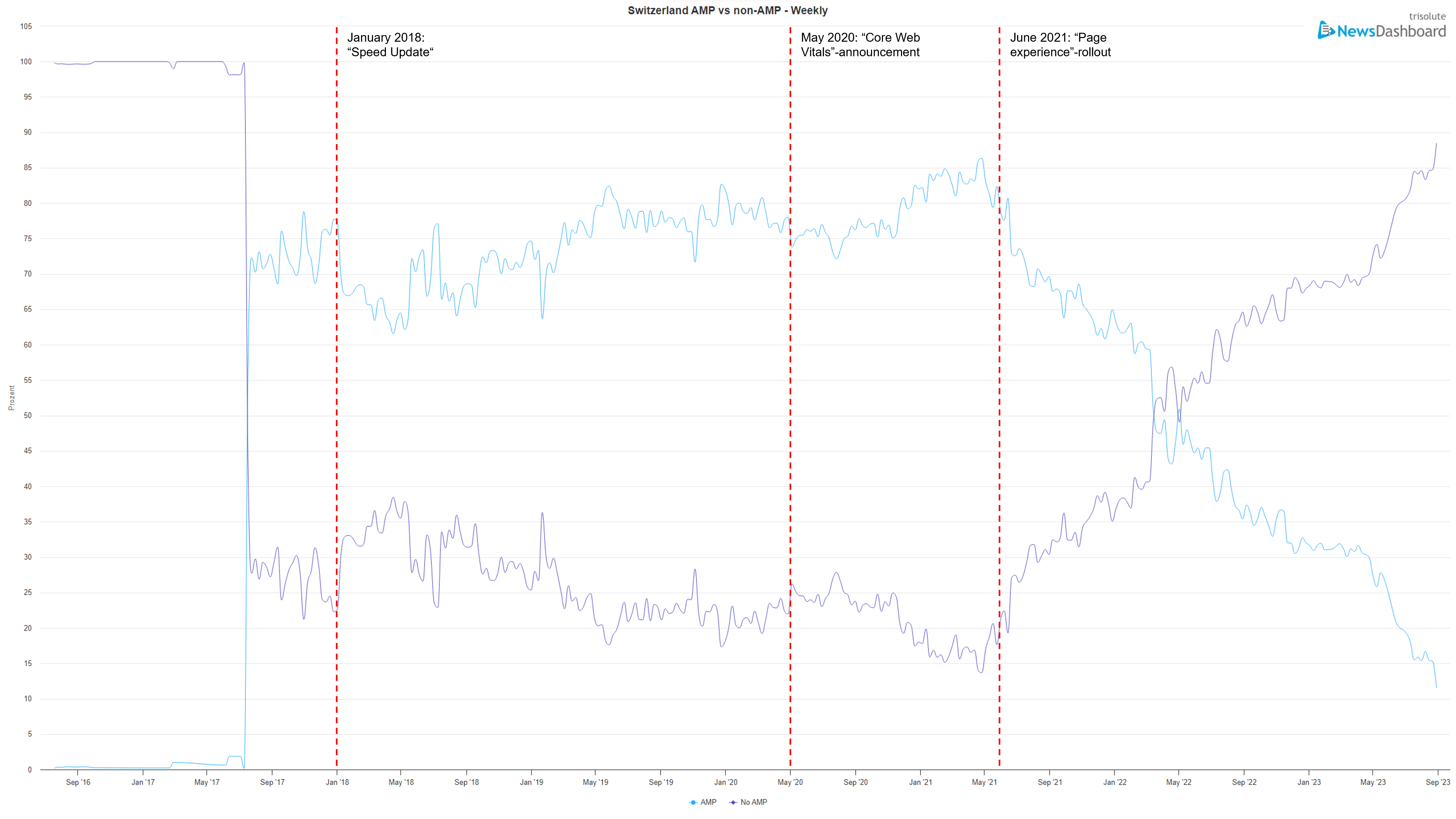
What sticks out in this visualization of the share of AMP vs non-AMP-articles in Switzerland is that AMP seems to only have become significant here between July and September of 2017 – at least 14 months later than the AMP-usage in Germany. At that point, though, the share of AMP-articles skyrocketed from 0% to over 70%. The fluctuations here seem a little more substantial from there on when compared to Germany. This is why at the time of the “Speed Update” in January 2018, although there was a decrease from around 78% to around 67% of articles using AMP, this change cannot be connected to the “Speed Update” with 100% certainty. Looking at the German data on AMP vs non-AMP from before though, it seems quite likely that those changes could be connected to the update in Switzerland as well.
From this point onwards, there was a slight rising tendency of articles using AMP. After Google’s announcement of “Core Web Vitals” in May 2020, the share of AMP-articles fell again slightly for about three months before re-rising to its peak in May 2021 at around 87%. One month later in June 2021, the “Page Experience”-rollout for all users happened – and it shows! From June 2021 until September 2023, the share of AMP-articles dropped from 81% to 12% – a drop of nearly 70 percentage points!
Like it was the case in Germany, eventually the share of articles without AMP replaced the share of articles with AMP as the majority. For Switzerland, this switch happened in April 2022.
U.K.
In the U.K., the first “Speed Update” in January 2018 shows a clear decrease of AMP-articles, with their share falling from 95% to 83% within the span of a month. For the following three years, the trend remained relatively steady with only a slight rising trend between January and August of 2019. The “Core Web Vitals”-announcement in May 2020 did not seem to have any influence on AMP-articles in the U.K.
That’s another story for the “Page experience”-rollout in June 2021, though. As it was the case in both Germany and Switzerland, the share of articles using AMP saw a major drop from that time on. From June 2021 until September 2023, the share dropped by 42 percentage points – from 86% down to 44%. The difference to Germany and Switzerland here is that the articles not using AMP did in fact not surpass the ones that did in 2022, but a a year later in May 2023.
U.S.
In the U.S.-context, the share of articles using AMP saw quite intense fluctuations in 2016 and 2017. At around 96%, it saw its peak in January 2018 – right when Google announced the “Speed Update”. Following that, the share fell by about 15 percentage points within a month. Despite the prior fluctuations, this certainly looks like it could be connected. After this drop, the trend remained relatively steady for a year, and then slightly rose for another year until January 2020. Though after that a slight drop in shares can be observed, there seems to be no apparent change following the “Core Web Vitals”-announcement.
The “Page Experience”-rollout in June 2021, on the other hand, resulted in a major drop of the share in AMP-articles. While it stood at 89% in June, it dropped down to 74% in August – 15 percentage points. After that, the share continued dropping, though more steadily. Like it was the case in the U.K., though, the share of non-AMP-articles does not surpass the AMP-article one in 2022, but one year later in May 2023.
AMP vs non-AMP – Key findings:
- There was a noticeable drop in the share of AMP-articles following the “Speed Update” in January 2018 in all four countries.
- The number of percentage points (p.p.) that the shares dropped by were all quite similar in all observed countries and looked as followed:
- Germany: 14 p.p.
- Switzerland: 11 p.p.
- U.K.: 12 p.p.
- U.S.: 15 p.p.
- In Switzerland, basically no AMP-articles existed up until mid-2017.
- No apparent change in shares related to Google’s announcement of the “Core Web Vitals” in May 2020 could be observed in any of the four countries.
- The biggest drop in the share of AMP-articles for all four countries happened in the aftermath of the “Page Experience”-rollout in June 2021. The percentage points the shares dropped by within 27 months (June 2021 – September 2023) were as followed:
- Germany: 73 p.p. (88% → 15%)
- Switzerland: 68 p.p. (81% → 13%)
- U.K.: 41 p.p. (86% → 45%)
- U.S.: 52 p.p. (89% → 37%)
- In both Germany and Switzerland, the share of non-AMP-articles eventually surpasses the share of AMP-articles in May 2022, following the “Page Experience”-rollout.
- In the U.K. and U.S. this surpassing happens one year later in May 2023.
Different Ranking Types: News Carousel, News Headline, News Text
After looking at the general distribution of articles using AMP vs the ones that do not, it seems plausible to dive a little deeper and distinguish between different ranking types. The three major ranking types were News Carousels, News Headlines, and News Text. To get a detailed overview of what those ranking types contain, check out this article.
A little side note on the distribution of the different ranking types that contain AMP, or that do not: The abolition of AMP for one ranking type (e. g. AMP news_carousel) does not automatically mean that its non-AMP-counterpart (e. g. No AMP news_carousel) gets the equivalent share back, like it was the case for the AMP vs non-AMP-instances. When AMP is abolished for one ranking type, that share could also be redistributed onto another ranking type. For example, a News Carousel with AMP could very well turn into a News Text with AMP, which would also result in a change of distribution.
Germany
“Speed Update” (January 2018):
When Google announced the “Speed Update” on January 17 2018, the most noticeable fluctuation that can be observed with German publishers is the drop of the share of AMP news carousels by 34 percentage points (77% → 43%). After this drop, the share remained relatively steady, except for a few fluctuations mid-2018 which, however, smoothed out again.
AMP News Texts as well as non-AMP News Headlines saw a rather noticeable raise in their percentage, with an eight-percentage-point-increase for News Text (13% → 21%) and a ten-percentage-point-increase for non-AMP News Headlines (7% → 17%).
The increase of non-AMP News Text and of non-AMP News Headlines also saw an increase in their percentages, albeit only a small one. For non-AMP News Carousel, there does not seem to be any fluctuation around the time of the “Speed Update”.
“Core Web Vitals”-announcement (May 2020):
None of the different ranking types, both with or without AMP seem to have been seriously affected by this announcement, which Google made on May 5 2020. For non-AMP News Carousels, a minor increase can be made out, but since it already begins in January 2020, the chances that this increase are due to the announcement are quite low.
“Page experience”-rollout (June 2021):
As it had been the case with the general AMP vs. non-AMP-observation, this milestone, which happened on June 15 2021, resulted in the most major changes in the different ranking types’ distribution. Most noticeable here is the switch of positions for AMP and non-AMP News Carousels. While the share of News Carousels with AMP started at 81% in June 2021 and dropped to as low as 14% (67 percentage points) just over two years later in September 2023, the non-AMP-carousels saw an increase of 78 percentage points (6% → 84%) in the same amount of time. Here, it seems like the direct transfer of AMP to non-AMP-share happened after all.
While the share of AMP and non-AMP News Headlines saw a minor decrease that is not really noteworthy around the time of the rollout, AMP and non-AMP News Text were already bordering 0% and were therefore not affected by it. This drop to 0% occurred in January 2021, where AMP News Text dropped by almost 24 and its non-AMP counterpart by about 9 percentage points. At the same time, the share of AMP News Carousels skyrocketed from 49% to 76% within a month, which could hint at a redistribution from News Text to News Carousels.
Switzerland
Like it has been suggested with the AMP vs non-AMP graphic for Switzerland, it here becomes evident once again that AMP seems to not have been used in this country prior to mid-2017 and has therefore been established later than in the other countries compared.
“Speed Update” (January 2018):
Like in Germany, the AMP News Carousel saw the most evident fluctuation at the time of the “Speed Update”, with a drop of around 22 percentage points (46% → 24%) within a month. While non-AMP News carousels were already at 0% at that time and nothing happened with that share, the other instances (AMP and non-AMP News Headline, AMP and non-AMP News Text), all saw more or less minor increases in their percentages.
“Core Web Vitals”-announcement (May 2020):
Here it is also not apparent that any of the instances suffered major fluctuations around the time of the “Core Web Vitals”-announcement. Like it was the case in Germany, at the beginning of 2021, AMP and non-AMP News Text dropped to 0% (AMP News Text dropped from 21% and non-AMP News Text from 8%), from which none of them have recovered. At the same time, AMP News carousel saw an increase of 25 percentage points, from 43% to 68%. This hints at a direct distribution from one to the other.
“Page experience”-rollout (June 2021):
Once again, this rollout brought along some major changes in the world of AMP. While the share of AMP News Carousels dropped from 57% in June 2021 to 11% in September 2023 (46 percentage points), the share of its non-AMP counterpart rose from 7% up to 84% (77 percentage points) in the same time-span.
The shares of AMP and non-AMP News Headlines both saw an apparent decrease after the rollout in June. AMP News Headline dropped by 22 percentage points, from 23% to 1%, and non-AMP News Headline lost 9 percentage points by dropping from 13% to 4%. Both News Text instances were already at nearly 0% at that time and thus did not show any fluctuation.
U.K.
“Speed Update” (January 2018):
Like it was the case for the previous two countries, the share of AMP News Carousels saw the most apparent fluctuation at the time of this update: its percentage dropped from 81% to 45% (36 percentage points) within a month.
All other instances except for the non-AMP News Carousels, which remained at 0% at that time, saw an increase in their share:
- AMP News Text: 16 percentage points – 7% → 23%.
- non-AMP News Text: 3 percentage points – 4% → 7%.
- AMP News Headline: 10 percentage points – 6% → 16%.
- non-AMP News Headline: 4 percentage points – 3% → 7%.
“Core Web Vitals”-announcement (May 2020):
Once again, the “Core Web Vitals”-announcement from May 28, 2020 did not result in fluctuations as immense as with the “Speed Update”. For the AMP News Carousels, the no AMP News Headlines and the no AMP News Text, no obvious changes in shares could be made out when the announcement was made.
The AMP News Headline saw a slight rise of around 5 percentage points (6% → 11%), while there was a slight drop in shares for AMP News Carousels (54% → 49%) and AMP News Text (33% → 28%). It should not be disregarded, though, that slight fluctuations like that could be observed at other points in time, which is why the above-mentioned ones may not necessarily be the direct result of the “Core Web Vitals”-announcement.
“Page experience”-rollout (June 2021):
Even before the “Page experience”-rollout took place in June 2021, AMP News Text and AMP News Carousels saw major fluctuations in their shares: While AMP News Text was at around 24% in January 2021, it dropped to 0% within a month and never recovered. At the same time, the share AMP News Carousels was at around 54% and rose by 25 percentage points, up to an astonishing 74%, also within a month. No AMP News Text also dropped to near 0% at the same time, although its share was already only at around 4%.
When the “Page experience” was finally rolled out in June 2021, the AMP News Carousels that saw such an extreme only a few months before, suddenly started to drop gradually. While they were still at 79% in June, they dropped by 35 percentage points in the span of 26 months, standing at 44% in September 2023. At the same time, no AMP News Carousels saw a noticeable increase of almost 50% in their share, starting at 6% in June ’21 and landing at 54% in September ’23. In June 2023, the share of no AMP News Carousels overtook the share of AMP News Carousels.
AMP News Headlines and no AMP News Headlines’ shares dropped to near 0% at the time of the rollout and never recovered.
U.S.
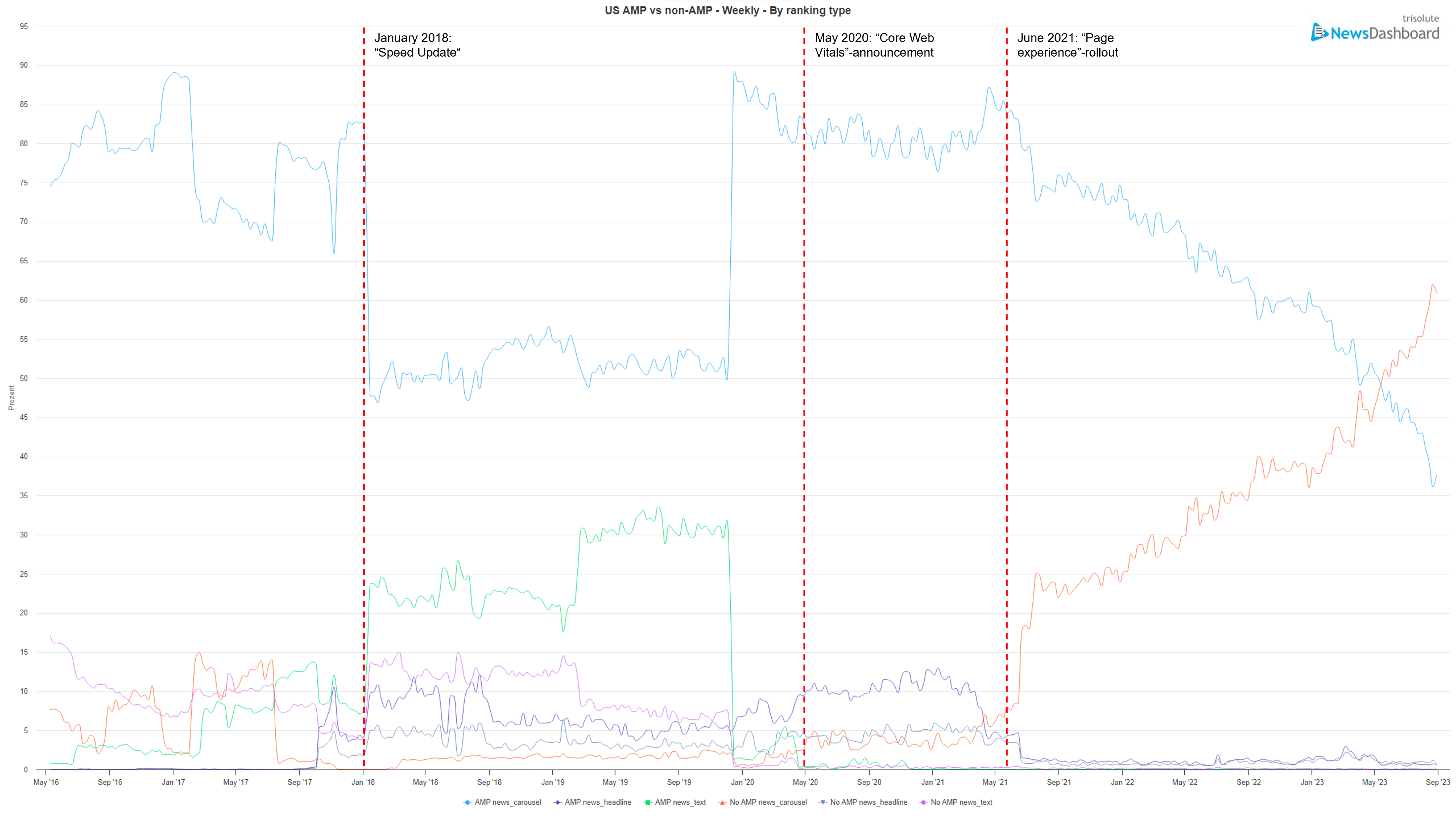
“Speed Update” (January 2018):
Once again, the “Speed Update” from January 2018 had an immense impact on the shares of different ranking types in the U.S. Most noticeably, the share of AMP News Carousels dropped by 35 percentage points – from 83% in January 2018 down to 48% in February 2018. Its counterpart, the no AMP News Carousels, saw no fluctuation at the time of the update, as its share had already dropped to 0% two months before.
All other ranking types – AMP or non-AMP – saw a rise in shares that came with the update. Here are the exact numbers:
- AMP News Text: 16 percentage point-rise – 8% → 24%.
- no AMP News Text: 10 percentage point-rise – 4% → 14%.
- AMP News Headline: 6 percentage point-rise – 4% → 10%.
- no AMP News Headline: 2 percentage point-rise – 3% → 5%.
“Core Web Vitals”-announcement (May 2020):
As it was the case with other countries before, the “Core Web Vitals”-announcement did not bring along the greatest fluctuations. AMP News Carousel and AMP News Text saw huge variations in their curves before the announcement, though: In December 2019, the share of AMP News Carousels rose from 50% to almost 90% within a month, while AMP News Text dropped from 31% to near 0% in the same time.
“Page experience”-rollout (June 2021):
While both AMP News Text and no AMP News Text were both at 0% at the time of the “Page experience”-rollout in June 2021, AMP News Headline and no AMP News Headline saw a decrease in their shares, which eventually brought them to almost 0% as well for the time coming.
As in the other countries observed, the share of AMP News Carousels also dropped majorly with the rollout. While it stood at 85% in June 2021, it gradually dropped by almost 50 percentage points down to 36% in September 2023. At the same time, the share of non-AMP News Carousels rose by 55 percentage points: from 7% in June 2021 up to 62% in September 2023. The share of non-AMP News Carousels overtook the share of AMP News Carousels in June 2023, exactly two years after the “Page experience”-rollout.
Different Ranking Types – Key findings:
Overall, the key findings were quite similar in all four countries. Here’s an overview of what happened at the times of the “Speed Update”, the “Core Web Vitals”-announcement and the “Page experience”-rollout:
“Speed Update” (January 17, 2018):
- In all four countries, Google’s “Speed Update” led to a significant decline in the share of AMP News Carousels, with fluctuations ranging from 22 percentage points (Switzerland, 46% → 24%) to 44 percentage points (Germany, 77% → 43%). In the U.K. the decline was 36 percentage points (81% → 45%) and in the U.S. 35 percentage points (83% → 48%).
- The U.K. and the U.S. also saw noticeable increases in AMP News Text (both by 16 percentage points), while Germany saw a slight increase in non-AMP News Headlines (10 percentage points).
- In Switzerland, no apparent fluctuations other than the decrease of AMP News Carousels could be observed around the time of the “Speed Update”. This could have to do with its delayed adoption of AMP, compared to the other countries.
“Core Web Vitals”-announcement (May 28, 2020):
- Across all four countries, the “Core Web Vitals”-announcement had minimal impact on the shares of the different ranking types, with no significant changes except for occasional minor fluctuations.
- Notably, AMP News Carousels in Germany and Switzerland saw slight shifts towards non-AMP during this period.
“Page experience”-rollout (June 15, 2021):
- The “Page experience”-rollout had the most significant impact across all four countries, resulting in a marked shift from AMP to non-AMP News Carousels. The fluctuations were as followed:
- Germany: AMP News Carousels: Drop of 67 percentage points (81% → 14%); non-AMP News Carousels: Increase of 78 percentage points (6% → 84%).
- Switzerland: AMP News Carousels: Drop of 43 percentage points (57% → 11%); non-AMP News Carousels: Increase of 77 percentage points (7% → 84%).
- U.K.: AMP News Carousels: Drop of 35 percentage points (79% → 44%); non-AMP News Carousels: Increase of 48 percentage points (6% → 54%).
- U.S.: AMP News Carousels: Drop of 47 percentage points (85% → 38%); non-AMP News Carousels: Increase of 49 percentage points (6% → 55%).
- AMP News Text dropped to near 0% in all countries except Switzerland, suggesting a move away from this format.
- Non-AMP News Carousels gained dominance and overtook AMP News Carousels in all four countries. In Germany and Switzerland this happened around one year after the rollout, in the U.K. and the U.S. it took around two.
Conclusion – Is AMP still worth using?
The analysis of AMP (Accelerated Mobile Pages) across Germany, Switzerland, the U.K., and the U.S. reveals a dynamic landscape in which AMP’s significance has evolved over time.
Following the “Speed Update” in January 2018, there was a significant decline in the share of AMP articles across all four countries. This decline was characterized by a notable drop in percentage points, ranging from 11 to 15 within as little as a month, indicating a clear shift in usage patterns.
While the “Core Web Vitals” announcement in May 2020 had minimal impact on AMP usage, the most significant change occurred after the “Page Experience” rollout in June 2021. During this period, the share of AMP articles experienced a substantial decline, with percentage point drops ranging from 41 to 73. This marked a pivotal moment when non-AMP content started to gain dominance.
Interestingly, the data suggests different regional trends. Germany and Switzerland appear to have transitioned away from AMP rather swiftly, possibly to implement their own alternative speed optimization strategies.
In contrast, publishers in the U.K. and U.S. seem to have held on to AMP for longer. Though a noticeable drop in AMP-usage can be observed after the “Page experience” rollout, the share of non-AMP articles surpasses the share of AMP articles happens a whole year later than in Germany and Switzerland. Accordingly, there still is more AMP-content in the U.K. and U.S. than in Germany and Switzerland.
In conclusion, while AMP was once a prominent feature for optimizing mobile web pages, its relevance has gradually diminished over time. The data suggests that the decision to use AMP depends on specific context and goals. Still, it is clear that AMP has seen a decreasing reliance in favor of non-AMP content in the ever-evolving landscape of search engine rankings.
Are you interested in gaining more data-based insights into news SEO? Check out these articles:
– Which Role do Video Rankings Play in News Boxes?
– Does the Age of your Article Affect its News Box Visibility?
– What Defines a Top-Ranking Article on Google Discover?
– AI in the Newsroom: Opportunities, Threats, Action Steps
To never miss new articles and other updates, follow us on LinkedIn and X.
Not yet part of the Trisolute News Dashboard family? Request your FREE demo today and find out how your articles rank on Google Discover, Google News and the SERPs!
